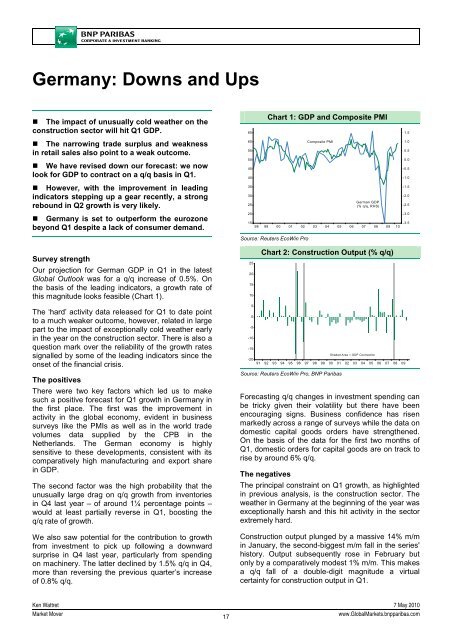Market Economics | Interest Rate Strategy - BNP PARIBAS ...
Market Economics | Interest Rate Strategy - BNP PARIBAS ...
Market Economics | Interest Rate Strategy - BNP PARIBAS ...
You also want an ePaper? Increase the reach of your titles
YUMPU automatically turns print PDFs into web optimized ePapers that Google loves.
Germany: Downs and Ups<br />
• The impact of unusually cold weather on the<br />
construction sector will hit Q1 GDP.<br />
65<br />
Chart 1: GDP and Composite PMI<br />
1.5<br />
• The narrowing trade surplus and weakness<br />
in retail sales also point to a weak outcome.<br />
• We have revised down our forecast: we now<br />
look for GDP to contract on a q/q basis in Q1.<br />
• However, with the improvement in leading<br />
indicators stepping up a gear recently, a strong<br />
rebound in Q2 growth is very likely.<br />
• Germany is set to outperform the eurozone<br />
beyond Q1 despite a lack of consumer demand.<br />
60<br />
55<br />
50<br />
45<br />
40<br />
35<br />
30<br />
25<br />
20<br />
15<br />
98 99 00 01 02 03 04 05 06 07 08 09 10<br />
Source: Reuters EcoWin Pro<br />
Composite PMI<br />
German GDP<br />
(% q/q, RHS)<br />
1.0<br />
0.5<br />
0.0<br />
-0.5<br />
-1.0<br />
-1.5<br />
-2.0<br />
-2.5<br />
-3.0<br />
-3.5<br />
Survey strength<br />
Our projection for German GDP in Q1 in the latest<br />
Global Outlook was for a q/q increase of 0.5%. On<br />
the basis of the leading indicators, a growth rate of<br />
this magnitude looks feasible (Chart 1).<br />
25<br />
20<br />
15<br />
10<br />
Chart 2: Construction Output (% q/q)<br />
The ‘hard’ activity data released for Q1 to date point<br />
to a much weaker outcome, however, related in large<br />
part to the impact of exceptionally cold weather early<br />
in the year on the construction sector. There is also a<br />
question mark over the reliability of the growth rates<br />
signalled by some of the leading indicators since the<br />
onset of the financial crisis.<br />
The positives<br />
There were two key factors which led us to make<br />
such a positive forecast for Q1 growth in Germany in<br />
the first place. The first was the improvement in<br />
activity in the global economy, evident in business<br />
surveys like the PMIs as well as in the world trade<br />
volumes data supplied by the CPB in the<br />
Netherlands. The German economy is highly<br />
sensitive to these developments, consistent with its<br />
comparatively high manufacturing and export share<br />
in GDP.<br />
The second factor was the high probability that the<br />
unusually large drag on q/q growth from inventories<br />
in Q4 last year – of around 1¼ percentage points –<br />
would at least partially reverse in Q1, boosting the<br />
q/q rate of growth.<br />
We also saw potential for the contribution to growth<br />
from investment to pick up following a downward<br />
surprise in Q4 last year, particularly from spending<br />
on machinery. The latter declined by 1.5% q/q in Q4,<br />
more than reversing the previous quarter’s increase<br />
of 0.8% q/q.<br />
5<br />
0<br />
-5<br />
-10<br />
-15<br />
Shaded Area = GDP Contraction<br />
-20<br />
91 92 93 94 95 96 97 98 99 00 01 02 03 04 05 06 07 08 09<br />
Source: Reuters EcoWin Pro, <strong>BNP</strong> Paribas<br />
Forecasting q/q changes in investment spending can<br />
be tricky given their volatility but there have been<br />
encouraging signs. Business confidence has risen<br />
markedly across a range of surveys while the data on<br />
domestic capital goods orders have strengthened.<br />
On the basis of the data for the first two months of<br />
Q1, domestic orders for capital goods are on track to<br />
rise by around 6% q/q.<br />
The negatives<br />
The principal constraint on Q1 growth, as highlighted<br />
in previous analysis, is the construction sector. The<br />
weather in Germany at the beginning of the year was<br />
exceptionally harsh and this hit activity in the sector<br />
extremely hard.<br />
Construction output plunged by a massive 14% m/m<br />
in January, the second-biggest m/m fall in the series'<br />
history. Output subsequently rose in February but<br />
only by a comparatively modest 1% m/m. This makes<br />
a q/q fall of a double-digit magnitude a virtual<br />
certainty for construction output in Q1.<br />
Ken Wattret 7 May 2010<br />
<strong>Market</strong> Mover<br />
17<br />
www.Global<strong>Market</strong>s.bnpparibas.com
















